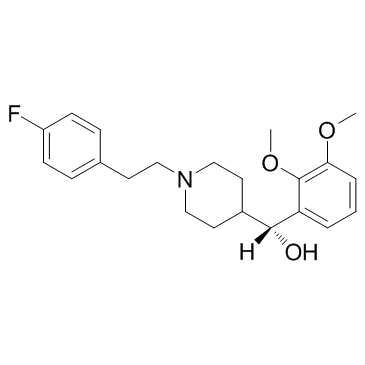| Cas No.: | 139290-65-6 |
| Chemical Name: | (R)-(+)-α-(2,3-Dimethoxyphenyl)-1-[2-(4-fluorophenyl)ethyl]-4-piperinemethanol |
| Synonyms: | MDL-100907;MDL100907;M100907;M 100907;Volinanserin |
| SMILES: | COC1C(OC)=CC=CC=1C(C1CCN(CCC2C=CC(F)=CC=2)CC1)O |
| Formula: | C22H28FNO3 |
| M.Wt: | 373.46 |
| Purity: | >98% |
| Sotrage: | 2 years -20°C Powder, 2 weeks 4°C in DMSO, 6 months -80°C in DMSO |
| Publication: | [1]. Sorensen SM, et al. Characterization of the 5-HT2 receptor antagonist MDL 100907 as a putative atypical antipsychotic: behavioral, electrophysiological and neurochemical studies. J Pharmacol Exp Ther. 1993 Aug;266(2):684-91. [2]. Ardayfio PA, et al. The 5-hydroxytryptamine2A receptor antagonist R-(+)-alpha-(2,3-dimethoxyphenyl)-1-[2-(4-fluorophenyl)ethyl-4-piperidinemethanol (M100907) attenuates impulsivity after both drug-induced disruption (dizocilpine) and enhancement (antidepressant drugs) of differential-reinforcement-of-low-rate 72-s behavior in the rat. J Pharmacol Exp Ther. 2008 Dec;327(3):891-7. |
| Description: | Volinanserin is a potent and selective antagonist of 5-HT2 receptor, with a Ki of 0.36 nM, and shows 300-fold selectivity for 5-HT2 receptor over 5-HT1c, alpha-1 and DA D2 receptors. Volinanserin has antipsychotic activity. |
| Target: | Ki: 0.36 nM (5-HT2 receptor)[1] |
| In Vivo: | Volinanserin (MDL 100907; 0.008-2.0 mg/kg, i.p.) significantly decreases d-amphetamine-stimulated locomotor activity in mice, with an ED50 of 0.3 mg/kg, but shows no obvious reduction in the base-line locomotor activity in mice. Volinanserin produces atalepsy with an ED50 of 10-50 mg/kg in rats. Volinanserin does not reduces apomorphine-induced stereotypies or produces catalepsy in rats[1]. Volinanserin (M100907) combined with MK-801 significantly decreases reinforcers at 1 μg/kg, but dose-dependently (10, 100 μg/kg) antagonizes the disruptive effect of MK-801 in rats via i.p. administration. Volinanserin (6.25 μg/kg) enhances the antidepressant-like action of desipramine in rats performing under a DRL 72-s schedule, and elevates the antidepressant-like effect of tranylcypromine[2]. |
| In Vitro: | Volinanserin (MDL 100907) is a potent antagonist at the 5-HT2 receptor, with a Ki of 0.36 nM, and shows 300-fold selectivity for 5-HT2 receptor over 5-HT1c receptor, alpha-1 and DA D2 receptors. Volinanserin has antipsychotic activity[1]. |
| Animal Administration: | Mice[1] To measure the effects the test compounds alone on spontaneous locomotor activity, mice are injected i.p. with the test compounds, placed singly into clear Plexiglas test cages (16 × 16 × 8 inches) and are allowed to acclimatize for 30 mm. Six mice per dose for each of the six doses are tested for Volinanserin (0.008-2.0 mg/kg), amperozide and haloperidol. Twelve mice per dose for six doses are tested for clozapine. Sixty animals are given vehicle in these experiments. Thereafter, the boxes are placed in the activity monitors and measurements are taken for 30 mm. To measure the effects of various pretreatments on amphetamine stimulated motor activity, mice (four per test box) are acclimatized for 90 mm to reduce the level of spontaneous activity of the controls. The mice are then injected with amphetamine (2 mg/kg i.p.) as well as the test compounds, returned to the activity boxes and tested for 90 mm. In these experiments 16 mice per dose are tested for the 9 doses of Volinanserin and 16 mice per dose are tested for each of 6 doses for amperozide, clozapine and haloperidol. One hundred forty four mice received vehicle in these experiments[1]. Rats[1] Drugs and doses used are clozapine (1, 10 and 50 mg/kg) or Volinanserin (1, 10 and 50 mg/kg), amperozide (1, 10 and 50 mg/kg) and haloperidol (0.1, 0.3 and 1.0 mg/kg). Five rats per dose are used in these experiments and five rats receive vehicle. Rats are dosed i.p. and, 30 mm later, each rat is placed gently into a clear Plexiglas enclosure (30 × 30 × 15 cm) so that both front limbs rested on top of a horizontal aluminum rod (1.2 cm in diameter). The rod is centered across the plastic enclosure at a height of 7 cm above the floor. The time each rat remained with its hind legs on the floor while the front limbs are elevated on the rod is recorded to the nearest second. Data are analyzed by using analysis of variance followed by appropriate post-hoc tests[1]. |
| References: | [1]. Sorensen SM, et al. Characterization of the 5-HT2 receptor antagonist MDL 100907 as a putative atypical antipsychotic: behavioral, electrophysiological and neurochemical studies. J Pharmacol Exp Ther. 1993 Aug;266(2):684-91. [2]. Ardayfio PA, et al. The 5-hydroxytryptamine2A receptor antagonist R-(+)-alpha-(2,3-dimethoxyphenyl)-1-[2-(4-fluorophenyl)ethyl-4-piperidinemethanol (M100907) attenuates impulsivity after both drug-induced disruption (dizocilpine) and enhancement (antidepressant drugs) of differential-reinforcement-of-low-rate 72-s behavior in the rat. J Pharmacol Exp Ther. 2008 Dec;327(3):891-7. |

 To enhance service speed and avoid tariff delays, we've opened a US warehouse. All US orders ship directly from our US facility.
To enhance service speed and avoid tariff delays, we've opened a US warehouse. All US orders ship directly from our US facility.




















